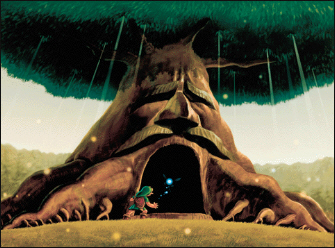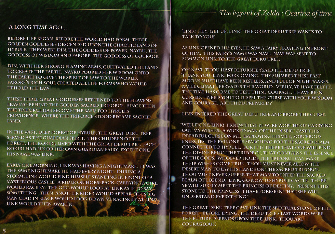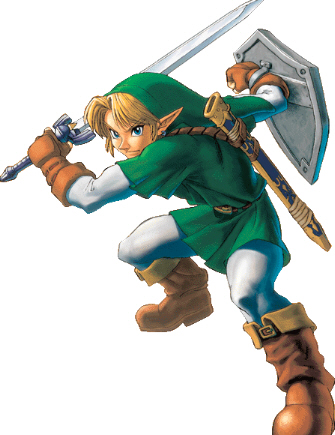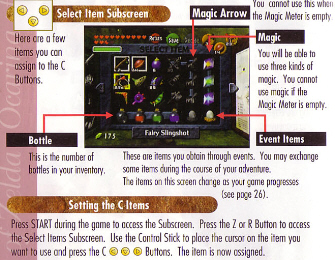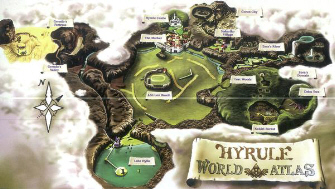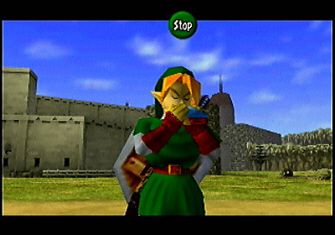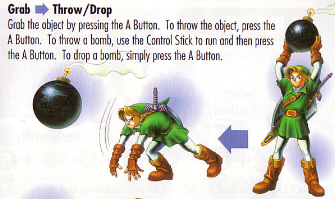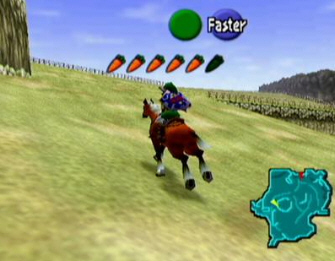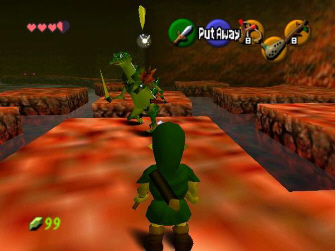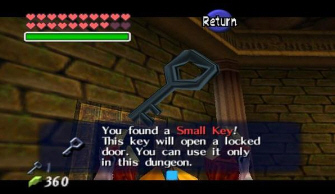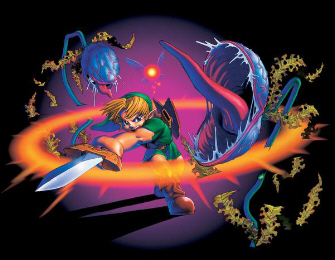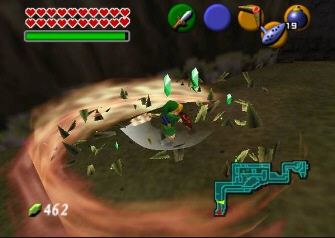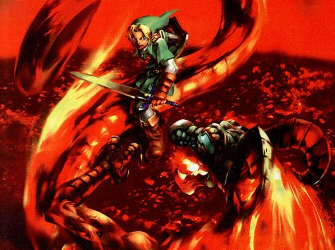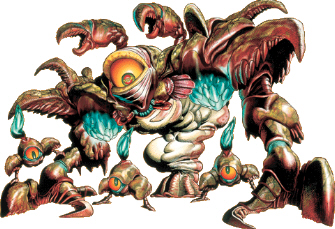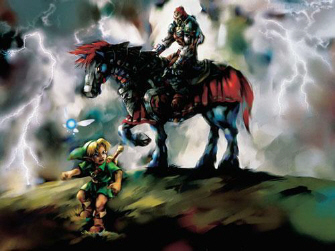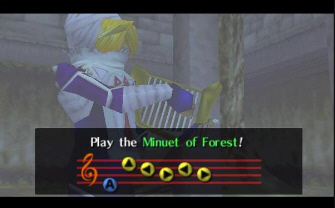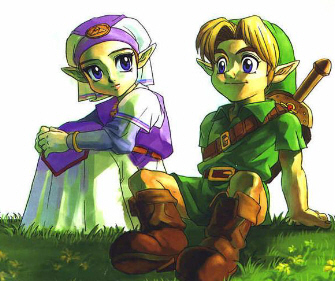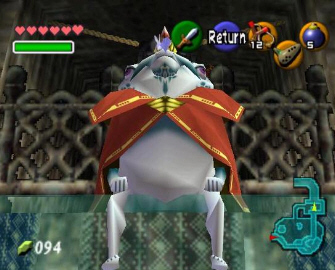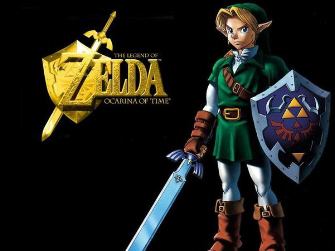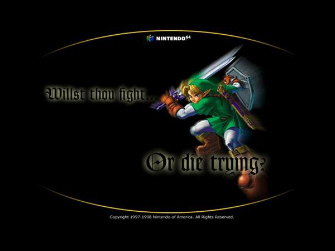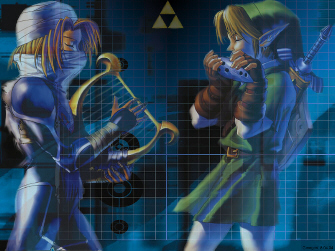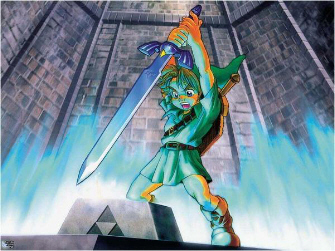 A Legend of Zelda: Ocarina of Time review in 2008? Believe it.
A Legend of Zelda: Ocarina of Time review in 2008? Believe it.
The Nintendo 64 outing of Link’s first three dimensional adventure is considered by many to be the best game of all time. Not the second best, not the best game on Nintendo 64 (although it most definitely would hold that title as well), no, the BEST GAME OF ALL TIME.
Suffice it to say that the game has gotten such high accolades, including many “perfect” review scores from gaming publications (who gave it all 10’s or whatnot), for a reason. The game is, quite simply, a force to be reckoned with.
In full discretion, Ocarina of Time is a game I have beaten quite a few times. Although for this review I replayed the entire game from start to finish.
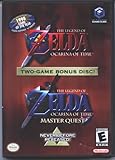 The version I reviewed was the GameCube “Zelda: Ocarina of Time / Master Quest” version which I played on the Wii. For the record, the Wii Virtual Console version is a port of the Nintendo 64 version minus the rumble support (which is included in the GameCube versions). I played it using the GameCube controller, although as stated, I have previously beaten the game on the Nintendo 64, as I also own that version.
The version I reviewed was the GameCube “Zelda: Ocarina of Time / Master Quest” version which I played on the Wii. For the record, the Wii Virtual Console version is a port of the Nintendo 64 version minus the rumble support (which is included in the GameCube versions). I played it using the GameCube controller, although as stated, I have previously beaten the game on the Nintendo 64, as I also own that version.
And with that, to the review!
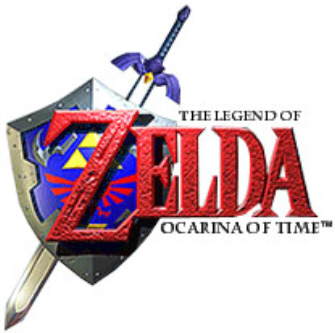
System: Nintendo 64
Also On: GameCube, Wii Virtual Console
Release Dates:
Nintendo 64 – USA November 23, 1998 – EUR December 11, 1998 – JAP November 21, 1998
GCN Master Quest – USA March 2003 – EUR May 2003 – JAP December 2002
GCN Zelda Collector’s Edition – USA November 17, 2003 – EUR November 14, 2003 JAP November 7, 2004 AUS March 19, 2004
Wii Virtual Console – USA February 26, 2007 – EUR February 23, 2007 – JAP February 27, 2007
Genre: Action Adventure
Players: Single Player
Save: Three save files. Must save manually by pressing the B Button on the Start Subscreens.
Developer: Nintendo EAD (Entertainment Analysis Development)
Publisher: Nintendo
Origin: Japan
Rated: E for Everyone. Contains: Violence
The Legend of Zelda: Ocarina of Time is such a huge game that I don’t even know where to begin. How about with some history.
Zelda: Ocarina of Time (originally called Zelda 64), was Link’s first 3D adventure and was the follow-up to the last SNES console Zelda title, The Legend of Zelda: A Link to the Past (which was followed by Zelda: Link’s Awakening on Game Boy). As such, there was huge hype built up for Ocarina of Time for years following it’s first public showing at Nintendo’s SpaceWorld trade-show in 1995 as an N64 technical demo.
The “Zelda 64” tech-demo from 1995’s SpaceWorld
Originally Zelda 64 was developed as a launch title for the Nintendo 64DD (“DD” being short for “Disk Drive”), a disk add-on for the Nintendo 64. Possibly sensing the troubled development and subsequent whimper of a release for the 64DD (which was never released outside of Japan), Nintendo wisely choose to move Ocarina of Time to the cartridge format for release on the Nintendo 64, which is ultimately what would happen (the 64DD would reach Nintendo Virtual Boy status as a legendary commercial failure).
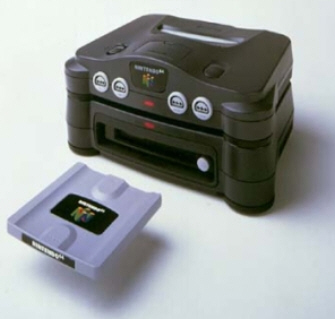
After a lengthy three-year development cycle, the game finally hit store shelves as “The Legend of Zelda: Ocarina of Time” in America on November 23rd, 1998, only two days after the game’s November 21st Japanese release date. It was released in Europe on December 11th, 1998.
Nintendo did end up releasing a Zelda for 64DD however, and it was a remixed version of Ocarina of Time with more difficult dungeons originally known as “Ura Zelda”. That game, and others like Doshin the Giant, were eventually either re-released on cartridge format, or in the case of the remixed Zelda, were released on disc format. Ura Zelda was released as The Legend of Zelda: Ocarina of Time: Master’s Quest and was included as part of a compilation GameCube disc (which contained Master’s Quest along with the regular version of Ocarina of Time) that was offered as a pre-order bonus for The Legend of Zelda: The Wind Waker as well as sold in a few GameCube system bundles. In Europe those who pre-ordered Wind Waker got the Master Quest disc inserted into The Wind Waker box and was available via a special Nintendo web-site.
Ocarina of Time was also released as part of The Legend of Zelda Collector’s Edition which you could get directly from Nintendo by registering software, subscribing to Nintendo Power or via GameCube system bundles. And in the United Kingdom via the Club Nintendo Stars Catalog and later Nintendo gave a copy to customers who mailed in proof of purchases from select Nintendo GameCube games
Last but not least, Ocarina of Time was eventually released for the Wii Virtual Console on February 26th, 2007 in the U.S. and February 23rd, 2007 in Europe. Making it more accessible than ever before for gamers new and old to get their hands on what some consider to be the greatest game of all time. The Virtual Console version of Ocarina of Time is the N64 version minus force feedback in the controller that you originally got with an N64 Rumble Pak. The game costs 1,000 Wii Points to purchase at the Wii Shop and takes up 286 Blocks of space in the U.S. and 296 blocks in Europe.
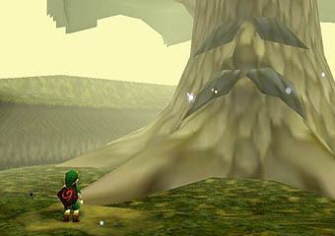
One of the main reasons why Ocarina of Time is so highly regarded, is due to the fact that Nintendo was able to so perfectly translate the 2D gameplay of the past into the 3D realm. This was Nintendo’s first time bringing the Zelda series into the third dimension, following a few other Nintendo big-shots like Starfox 64 and Super Mario 64, and thus the bar that had been set for the game was enormous. Thankfully, Ocarina of Time didn’t just clear the bar (on it’s first jump I might add), it sailed over it on wings!
Everything about the game was eye-popping back than, the graphics were amazing, the sound was good, the controls were unique, inspired, innovative and easy to grasp, and the game’s world was huge.
In 2008, the game no longer feels exactly innovative, but you can still appreciate all that was done back then to set down the foundation that Nintendo would follow with the later games in the Zelda series (including The Legend of Zelda: Majora’s Mask, The Legend of Zelda: The Wind Waker and The Legend of Zelda: Twilight Princess).
STORY
The Legend of Zelda: Ocarina of Time opens with a child Link, who is asleep in his bed having a nightmare. In the nightmare he is standing before a great castle in the rain as the gate lowers and a white horse comes zooming past him. In the saddle are a young girl being held by a women. As the horse zooms past him, Link gets a glimpse of the young girl’s worried face as she glances back. And with that, she’s gone. However she is followed by a black horse, this time carrying a young but powerful looking man glad in black armor. The scene ends with the camera zooming in on Link’s shocked face.
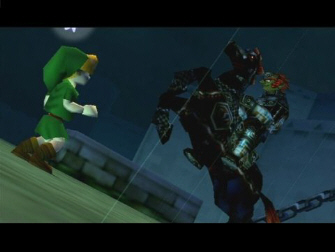
The game then cuts to the face of The Great Deku Tree, who was narrating before the nightmare scene, telling players that he is the guardian of his people, known as The Kokori. The Kokori live deep within the forest and he continues on by telling of “the boy without a fairy”. The Deku Tree then tells of how he senses a climate of evil descending upon the realm, the malevolent forces mustering to attack the land of Hyrule. Kokori Forest had long stood as the “source of life” and a barrier that deters outsiders and maintains the order of the world. But the oncoming force is too powerful even for The Great Deku Tree. That of course, is where Link steps in. And thus his adventure begins. To lead Hyrule “to the path of justice and truth.”
You then see the view from the eyes of Link’s new fairy, Navi (who will be your guide on this adventure) as she flies from the Deku Tree’s home in Kokori Forest to Link’s house, which is shown from a first-person viewpoint, giving players their first good look at Kokori Forest and it’s inhabitants. Navi comes into Link’s house to, of course, find him asleep and wakes him up with the now legendary voice clip of “Hey!”. “Can the destiny of the world really depend on such a lazy boy,” she says? She then tells Link that he has been summoned by the Great Deku Tree and must go meet him.
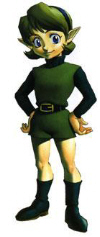 The Kokori Forest serves as the tutorial for the game, and you’ll learn all you need to know about the game by talking to the various child inhabitants who live in the Forest with you. You’ll also meet one of the main characters in the game, you’re best friend Saria, who is the first person to greet you after Link receives his Fairy. As well as Mido, the “boss” of the Kokori and a bully who likes to call himself “The Great Mido”.
The Kokori Forest serves as the tutorial for the game, and you’ll learn all you need to know about the game by talking to the various child inhabitants who live in the Forest with you. You’ll also meet one of the main characters in the game, you’re best friend Saria, who is the first person to greet you after Link receives his Fairy. As well as Mido, the “boss” of the Kokori and a bully who likes to call himself “The Great Mido”.
Soon after obtaining your Sword and Shield and learning how the game works, you will meet with The Great Deku Tree and enter inside him to complete your first dungeon, which serves as a kind of opening to what you can expect from later dungeons in the game, whose puzzles and enemies are much greater. Within you’ll find your first weapon (The Fairy Slingshot) as well as some new items. This is also where the story for the first half of the game is explained.
The Deku Tree explains to you that he has become cursed. Cursed by a “man from the desert” who used his sorceress magic to curse the Deku Tree on his quest to find the Sacred Realm, which is connected to Hyrule. This evil man searches ceaselessly for the Sacred Realm because it is within that you will find “that divine relic”, the Triforce.
You then will see one of the few actual cut-scenes in Zelda: Ocarina of Time (cut-scenes are done in real-time, and you will see them during some of the more important parts of the game’s story). It is with this opening scene that you will get a glimpse at the kind of Zelda lore that you will encounter throughout the game, something that really set Ocarina of Time apart from previous games, and set the precedent for a deeper story that would be followed by subsequent Zelda titles.

The scene shows three golden goddesses: Din (the Goddess of power), Nayru (the Goddess of Wisdom) and Farore (the Goddess of Courage) and, for the first time in the history of the Zelda series, explains how Hyrule was actually formed. It also explains how and why the Triforce was created.
The Triforce is the place from which the three golden goddesses left the world. The Triforce’s resting place became known as “The Sacred Realm” (known as “The Golden Land” in previous Zelda games like A Link to the Past), which became the basis for Hyrule’s providence. The Deku Tree warns that the “desert man in black armor” must never be allowed to lay his hands on the sacred Triforce.
He then gives you a gift, the Kokiri Emerald, and tells you to go meet the “princess of destiny” at Hyrule Castle. The Kokiri Emerald is one of the key’s to entering the Sacred Realm, and the reason that the desert man cast his “death curse” on The Deku Tree. It is the first of many sacred relics that you will collect on your adventure.
CONTROLS AND INTERFACE
When you first fire up Zelda: Ocarina of Time, you’ll be given access to three save files. You can not save any more than three games at once. From this screen you’ll have options to delete or copy a game file, as well as a few options that you can change under the Options Menu. These include the sound (stereo, mono, surround or “headset” for headphones) and how you want the L-Targeting to work. “Switch” means that pressing the L-Targeting button once will activate the lock-on cursor. “Hold” means that the cursor will only stay activated while the button is held down. There is also a bar on the Options Menu for you to figure out if the brightness settings on your TV are optimal. Once you select a file you’ll be asked to input your name. It’s important to note that whatever name you put, is what all the characters in the game will call you. So if you want the game to feel authentic, then input your name as “Link”. Otherwise, you can put whatever name you like.

After the game’s introduction and the story is given to the player (as explained above), you’ll find yourself in Kokori Forest, which acts as a training ground where you are taught how the game controls and how the interface works. But I’ll go ahead and explain them here.
Link’s new fairy, named Navi, allows you to lock onto objects and characters with the L Button, this is called “L Targeting” (or “Z targeting” in the N64 version as you used the Z Trigger Button). This was an innovation in 3D action gaming as it allowed you to focus the camera on an enemy or object in 3D space and then battle or strife around it without losing sight of the target. A big deal back in the day.
 By pressing the L Button you can lock onto characters, allowing you to easily talk with them or speak with a character from afar (which can only be done by locking onto them first). If there is nothing to target, then you press L to move the camera directly behind you. You can also hold L to keep the view looking forward while you strife around with the control stick.
By pressing the L Button you can lock onto characters, allowing you to easily talk with them or speak with a character from afar (which can only be done by locking onto them first). If there is nothing to target, then you press L to move the camera directly behind you. You can also hold L to keep the view looking forward while you strife around with the control stick.
The A Button is context-sensitive and will change depending on the situation, which was another innovation that Ocarina of Time popularized, even though it had been seen to an extent previously. When you are close to an object that you can interact with, you’ll see the A Button icon at the top of screen display in words what action you can perform, such as “speak” to talk to a character, “climb” to climb onto a ladder or block and “open” to open a door or chest.
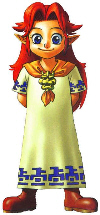 As a side note, when speaking to a character the text will scroll slowly. It’s just something you’ll have to deal with, pressing A won’t do anything, but if you press B while a character is talking it will skip all the way to the end of what they are saying. So it’s best to just have patience as you don’t want to accidentally skip something important. Which btw, important bits of information that will help you on your quest are highlighted in red or other colors.
As a side note, when speaking to a character the text will scroll slowly. It’s just something you’ll have to deal with, pressing A won’t do anything, but if you press B while a character is talking it will skip all the way to the end of what they are saying. So it’s best to just have patience as you don’t want to accidentally skip something important. Which btw, important bits of information that will help you on your quest are highlighted in red or other colors.
Next to the A Icon at the top of the screen is the B Button Icon, which will display your sword when you have obtained it. Pressing B will draw your sword. You can then swing it horizontally by just pressing B, or vertically by targeting and pressing B or pressing B while holding up/forward on the control stick (best way to swing horizontally is to just stand still and press B without targeting).
You can do a stabbing attack by targeting and pressing up and B, or a lunge attack by pressing A while targeting if your sword is drawn. If it is not drawn, then A will roll forward while targeting. The A Button will always make Link roll when you are not targeting, which is both a good way to avoid enemies and to help you get to a location quicker than running. You can also do a few more acrobatic moves while targeting with the A Button. While Targeting or holding down the L-Trigger button, you can do a backflip by pressing back+A or a side-jump by pressing Left or Right and the A Button.
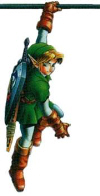 Finally, if you stand still for a while then you’ll be able to put your sword away with the A Button. Once you get a shield you can use R to block with it once it’s equipped. Pressing R while not targeting will have Link duck and hide behind the shield. To move while blocking with the shield you must target first.
Finally, if you stand still for a while then you’ll be able to put your sword away with the A Button. Once you get a shield you can use R to block with it once it’s equipped. Pressing R while not targeting will have Link duck and hide behind the shield. To move while blocking with the shield you must target first.
You use the control stick to run around. There is no jump button (although the only Zelda that contained one was Link’s Awakening) but you can leap over objects as well as climb onto them by simply running into them and Link will automatically perform the action you want.
So if you want to jump off an edge, just run at full speed towards it. And if it’s a movable object, like a box, then you will see “Grab” in the Action Icon and you can hold A to grab onto it, and use the control stick to move it around while keeping the A Button held. To climb atop it you’ll need to keep holding the control stick forward, so that the Action Icon changes from “grab” to “climb”.
Finally there are the C Buttons. You use the C Buttons on the N64 controller to use Items. If you are playing with a GameCube controller, then the N64’s four C Buttons (C Up, C Right, C Down and C Left) are mapped to both the C-Stick and the X, Y and Z Buttons. I have not played the Virtual Console version so I can’t tell you how the controls with the Classic Controller work, but the GameCube controls work just fine.
Items can be accessed via the game’s Subscreens. To bring up the subscreen menus, press the Start Button. The Menu is divided into four-parts. The Quest Screen shows items you pick up that are crucial to your quest, these you just carry around with you. Then you have the Equipment Subscreen. It is here that you will equip new swords, shields, tunics and boots. Then you have the Map Subscreen, which shows a map of Hyrule if you are out in the field. When you first begin the game most of the map is covered in clouds, but as you travel to new locations the clouds will disappear. You can see the various locations on the map and select them with the control stick to read their name. As well as see where you are in the world via a blinking icon on the map. Places you need to visit will also be blinking.
Finally you have the “Item” subscreen. It is here where you will see all items that you can equip for immediate use. To use them, you must set them to one of the C icons (displayed at the top right of the screen), either C Down, C Right, or C Left. Do this by moving the cursor to the item on the Item Subscreen and then pressing one of the C Buttons (on N64) or the corresponding direction on the right stick (GameCube, Classic Controller). If using a GameCube controller then the Y, X and Z buttons also correspond to C Buttons. Y is C Left, Z is C Down and X is C Right. You then will press that button or direction to use the Item. So if you set the Deku Sticks to C Right, then you’ll press C Right to take out the Deku Sticks and also to swing them. The A Button will allow you to put any item away (including your sword, as mentioned above) if you stand still for a few seconds.
You can’t use C-Up to equip items because that is used to change your viewpoint. Pressing C-Up while on the field will switch to a first-person viewpoint, or if you’re in a house it’ll switch to a top-down perspective. Navi will also occasionally chime in by yelling “Hey!” and you press up to hear her words of wisdom. She will occasionally call out to tell you where you need to be headed on your quest. She will also divulge useful information on enemies if you target them and press C Up. You can also Save while on the Subscreens at any time by pressing the B Button and confirming with A. Don’t forget to Save often!
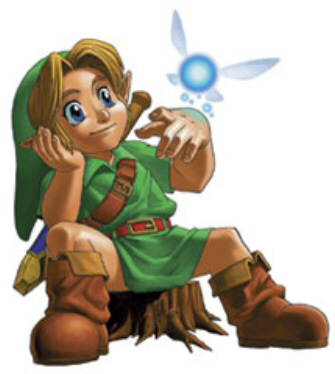
Finally comes the in-game display that you will see when running around (i.e., when the game isn’t on the Start Button subscreens). As previously mentioned, at the top of the screen you’ll see an A Button “Action Icon” that changes depending on the situation. Next to the A button at the top of the screen is a B Button icon which shows your sword if it’s equipped (Note: The colors of the B and A button icons differ depending on whether you are playing the N64 or GameCube versions, to mimic the colors of the A and B buttons on the corresponding controllers).
To the right of the B and A button icons at the top of the screen are the three C-Item Icons. C Left, C Down and C Right, if you set an item to them then it will show that item on the corresponding icon.
On the bottom right you can see how many Rupees you have, which is the game’s currency that you’ll use to purchase items from stores and such. And finally, to the upper left is your health, which is represented by small heart icons like in all Zelda games. Unlike games before Ocarina of Time though, the hearts drain in fourths as you take damage (instead of in halfs). And like all Zelda games, you can find Heart Pieces scattered around the world to increase your number of hearts and thus your health. Collect four “Pieces of Heart” to form one Heart Container. You’ll also gain a full heart after boss battles.
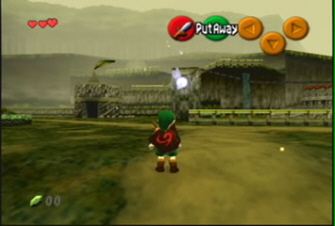
Finally, in the bottom right corner you will see a small mini-map of the area you are in. The yellow arrow on the mini-map is Link and it shows what direction he is pointing in and where he is in the current area. The red arrow simply shows the location you entered from (which can be useful when trying to determine what door you came out of). This mini-map can be turned off by pressing any direction on the D-pad.
Things change slightly when you are in a dungeon. The mini-map won’t be displayed until you find that dungeons map. And same goes for the Map Subscreen, which when in a dungeon will display the map for that dungeon. If you haven’t actually found the dungeon map though, then it will simply show what rooms you have already visited. Once you find the map, it will display the whole dungeon. On the left side you will see the various floors, move the cursor over to them and up or down to switch floors. Areas you have been to will be blue, while areas you have not visited will not be filled in with any color. Once you find the dungeon Compass, you can see where treasure chests in the map are located. As well as the floor and room that the dungeon boss is located in (who’s room you can’t enter unless you’ve found the “Boss Key” in most dungeons).
GAMEPLAY
The Legend of Zelda: Ocarina of Time is an epic, action adventure game. Early on you will learn the story of the land and the people that inhabit it. You will also meet many interesting characters and races along the way. From the titular Princess Zelda to the forest children known as the Kokori to the mountain-inhabiting rock-like Goron and the underwater fish-like Zora, to the mysterious “shadow folk” known as the Shekiah.
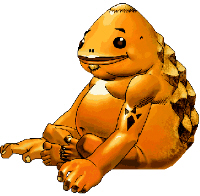 Ocarina of Time was also the first Zelda game to delve extensively into the Zelda lore and backstory, outside of the opening sequence. It was also the first Zelda game to reveal how the Triforce was created. And not only that, but you will also learn about the three Goddesses (Din, Farore and Nayru) and how they formed the land that Link and friends inhabit, known as Hyrule. On top of that, you will also meet Ganondorf and learn his backstory, in addition to the story of Link and how he came to be in Kokori Forest and much, much more. Suffice it to say that the storyline for The Legend of Zelda: Ocarina of Time is still one of the best in the series.
Ocarina of Time was also the first Zelda game to delve extensively into the Zelda lore and backstory, outside of the opening sequence. It was also the first Zelda game to reveal how the Triforce was created. And not only that, but you will also learn about the three Goddesses (Din, Farore and Nayru) and how they formed the land that Link and friends inhabit, known as Hyrule. On top of that, you will also meet Ganondorf and learn his backstory, in addition to the story of Link and how he came to be in Kokori Forest and much, much more. Suffice it to say that the storyline for The Legend of Zelda: Ocarina of Time is still one of the best in the series.
And as the title suggests, you will even travel through time and get to play as an older Link, where you will see the world from an entirely new perspective. The scene where you actually travel through time has to be seen to be believed, and it definitely ranks up there as one of greatest moments in Zelda history. And possibly, in gaming history.
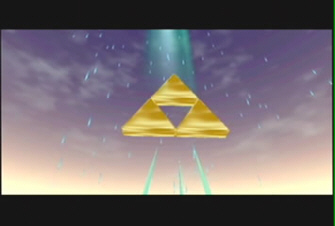
The flow of Ocarina of Time basically has you visiting towns and villages to learn of what immediate goal you need to satisfy to move the story forward, fighting random enemies along the way. The quest will eventually involve Link having to traverse his way through many dungeons to find various artifacts that are needed for the ultimate end-goals of both his Child and Adult forms.
Like in previous Zelda games, you start the game out with nothing and will acquire new weapons and items that will enhance your abilities and allow you to access further areas of the world that you could not get to before. And Ocarina of Time really took this feature above and beyond previous entries in the series.
Not only will you encounter all kinds of items on the Item Screen, including token items from Zelda’s past like Bombs, the Boomerang, a Bow and Arrow and Empty Bottles to store medicine and other things in. But they have expanded Link’s equipment ten-fold from the previous game, Zelda: A Link to the Past. And, for the first time, you can actually swap equipment in and out, although this will not play a major role until half-way through Link’s adventure.
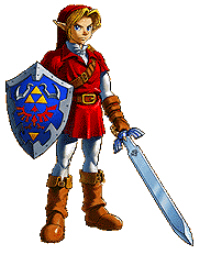 In addition to obtaining stronger swords and shields, you will also obtain new tunics and boots. And while these made appearances in previous games, this is the first time you were able to freely swap them in and out, and it plays a HUGE role in a lot of the puzzles and other aspects of the game later on, especially in some of the later dungeons.
In addition to obtaining stronger swords and shields, you will also obtain new tunics and boots. And while these made appearances in previous games, this is the first time you were able to freely swap them in and out, and it plays a HUGE role in a lot of the puzzles and other aspects of the game later on, especially in some of the later dungeons.
Now while swapping equipment may not seem like a major deal in this day and age (even if it was a first for the Zelda series), the fact remains that what it does do is give you a CRAP LOAD of stuff to play around with.
And boy is Zelda ever content packed! This game quite simply is one of the most completely satisfying single-player action adventures you will ever play. There is tons to do in Zelda: Ocarina of Time and you will be kept occupied from beginning to end, whether that’s traversing from one locale to the next, making your way through a dungeon or taking part in one of the numerous mini-games and side-quests. All of which (referring to the mini-games and side-quests) you will want to take part in because you’ll be awarded with an item for clearing the goal in each one, which encourages players to try their hand at everything at least once, if not a few times to get what you were looking for (which is not rupees, the game’s currency, that’s for sure).
 There are quite a few elements of Ocarina of Time that are very unique and separate it not only from other action adventure games, but also from other Zelda titles. And with Ocarina of Time that comes from the titular ocarina item. An ocarina is a flute-like instrument that you will obtain once you leave Kokori Forest for the first time.
There are quite a few elements of Ocarina of Time that are very unique and separate it not only from other action adventure games, but also from other Zelda titles. And with Ocarina of Time that comes from the titular ocarina item. An ocarina is a flute-like instrument that you will obtain once you leave Kokori Forest for the first time.
As you play the game you will learn various songs from different characters that you will encounter. Some of them are optional, but most will be required to beat the game. Typically you will either be taught an ocarina song as part of game’s storyline, or you will learn it by showing off your ocarina to certain characters. Simply whip the instrument out when you are within close distance of them and they will respond to the ocarina in your hand. Some characters will require you to play a song in order for you to proceed or earn something. As the game even tells you, when in doubt, pull out your Ocarina and play a tune!
The first song you will learn is a song that’s connected to the Royal Family of Hyrule called Zelda’s Lullaby, whose past you will learn more about during your adventure. The Royal Family, as you may have guessed, is Princess Zelda’s lineage and includes the King of Hyrule. Zelda’s Lullaby is a song you will play on the Ocarina that will be required to progress through many parts of the game where you will need to prove your connection to the Royal Family, which of course is done by playing the song.
To play notes on the Ocarina you use the four C button directions and the A Button. Although you can play anything you want on the ocarina, and even have fun by changing the tone and such with various buttons and directions on the control stick, you will have to play certain songs you have learned in order to have any effect on the game world (so you can’t expect to play the Simpsons Theme Song, which is doable, and have the game respond).
A short clip of The Simpsons Theme being played on the Ocarina
You will learn TONS of songs throughout the course of the game, and areas where you are required to play a song to progress in the story will show a music graph that pops up when you pull out your Ocarina. Although it won’t tell you which song you need to play as that is part of the fun, even when it’s obvious (such as when you see a Triforce symbol, which means you need to play Zelda’s Lullaby), so sometimes you’ll need to go through your entire songlist before you will figure out the right song that needs to be played. But having the music graph come up when a song is required takes a lot of the guess-work out of figuring out when a song is required to move the story forward. Which was a good idea on Nintendo’s part.
Thankfully though, the game is good at teaching you songs gradually so that you will generally have used them a few times before you learn the next one, and thus it’s easier to keep track of and/or memorize the songs as you learn them. If you forget how to play a certain tune (which you will, trust me) then you can check which songs you have learned and how to play them on the Quest Status Subscreen, where you will see a line of music notes (press the A Button and the game will give you a demonstration of the song).
A number of the items and weapons that you know and love from previous Zelda games also make their return in Ocarina of Time. They include Bombs, the Boomerang, the Bow and Arrow and empty bottles for you to put stuff in. And this time you can use Empty Bottles to carry a lot more than medicine, as you will find all kinds of things from small bugs to fish to fairys that you can catch by equipping an empty bottle and swinging it.
With certain weapons, such as the Slingshot, the game’s view will switch to first-person to allow for better and more accurate aiming. Although you can only use these weapons from a first-person vantage point, you can use L-Targeting to lock-on to an enemy if you are in range, which will zoom out the view to third-person viewpoint as well as allow you to track the enemy. If you have played newer Zelda games, then you may be a bit surprised to find that there is no aiming reticle or way to lock onto multiple enemies when using weapons like the boomerang. Nope this is straight up old-school aiming!
Most of the weapons work as you’d expect. Bombs can be dropped, and then picked up and thrown before they explode, allowing you to blast open cracked or hollow walls (hit them with your sword to tell if a wall is hollow and thus breakable, in classic Zelda fashion) or blow up certain large rocks that inhabit your progress. Deku Sticks can be pulled out and used as a blunt object or lit on fire and used to light torches. The bow and arrow can be used to shoot at far away switches and enemies. The Boomerang flies in an arch and will come back to you, also allowing you to pick up distant objects. The Shield can be used to block incoming shots from enemies or bounce them back at said enemy (such as with the classic Octorock enemies who will shoot rocks at you from the water) and so on and so forth.
The biggest twist in The Legend of Zelda: Ocarina of Time, of course, comes from it’s storyline. As is immediately revealed to you (via the back of the box or even the game’s intro), The Legend of Zelda: Ocarina of Time is split up into two halves. The first half has you playing as a young Link during childhood. But three sacred artifacts later, you will find yourself transformed into an Adult Link, the one you see riding the horse Epona during the game’s introduction when you first fire the game up on your N64, GameCube or Wii.
And while this is one of the greatest Zelda storylines due to how Link goes through time and into the future, it also has some gameplay implications. As Adult Link you will not be able to use the same weapons and items you used as a kid. You will also gain some new abilities that aren’t present in your childhood form.
The biggest example of this is Link’s horse Epona. Epona can only be ridden as Adult Link. She is also not readily available and must be earned. In fact, Epona is an entirely optional portion of the game, but something you will not want to go without. Once Link acquires Epona, you will be able to saddle up onto the horse and ride around the large Hyrule Field, the overworld portion of the gameworld that links all the various areas of Hyrule together.
From Hyrule Field you can access Kokori Forest, the Gerudo Valley, the Hyrule Market, Lake Hyrule, Zora’s Domain and Kokariko Village. When you are a kid this field takes a while to traverse on foot. Which is one of the annoying parts of Zelda: Ocarina of Time, as you will be forced to listen to Link’s annoying grunts and “hee-yah!”s as you roll your way from one end of the field to the other. You will do this because rolling is MUCH quicker than Link’s relatively low running speed.
Thankfully this little “issue” (which doesn’t effect gameplay, it’s just annoying much in the way that the sailing in The Legend of Zelda: The Wind Waker is) is rectified once you go into adulthood and obtain Epona, which allows you to speed across the field at a much quicker pace, and is also simply much FUNNER than rolling or running. You can even shoot your bow and arrow from Epona’s back (which will occasionally be used to fight ghost enemies), as well as hop over fences if you have enough speed and don’t approach them from a weird angle. In addition standard enemies that will sometimes attack when you are out in the field can be destroyed simply by running into them with Epona.
Epona can be summoned via the way of a special song that you can (optionally) learn while you are a child, and it will become a trusty part of your arsenal as it allows you to summon Epona from anywhere in Hyrule Field. Although you cannot take Epona into most of the other areas that are connected to Hyrule Field (with a few exceptions, namely Lake Hyrule and Gerudo Valley). Either way, Epona is a brilliant addition to the Zelda universe and to Ocarina of Time, and back in the day it was one of the neatest parts about Ocarina of Time, as it was one of the first times you had a 3D character ride a horse in that fashion. Nowadays we have games like Assassin’s Creed where the main character rides a horse, but Zelda was one of the first to do so and it is still a very cool part of Ocarina of Time and a fun, unique way to get around as Adult Link.
And Epona isn’t the only way you can get around quickly during the course of your adventure. During the Adult portion you will learn a very large variety of songs that will teleport you to various parts of Hyrule. Although this will, in some ways, make Epona obsolete, it is a very crucial part of the game and also a very player friendly one. Once you know the songs (which are very cool to play and memorize due to their fantastic orchestral sound) and are able to teleport anywhere in the blink of an eye, you will wonder how you ever played the game without them.
These songs are taught to you by a mysterious new character to The Legend of Zelda lore named Sheik (whom you may know from Super Smash Bros. Brawl), a character that made it’s debut in Ocarina of Time. Sheik is one of the coolest characters in the game and will impart you with sage-like advice and interesting perspectives on life as the mysterious Sheikah teaches you the songs of teleportation. Some memorable lines of Sheik’s eternal wisdom include stuff like this: “A childish mind will turn to noble ambition . . . Young love will become deep affection . . . The clear water’s surface reflects growth”. The character simply serves to make the storyline of Ocarina of Time that much more appealing as it gives a more serious tone to what is one of the best storylines in the Zelda series.
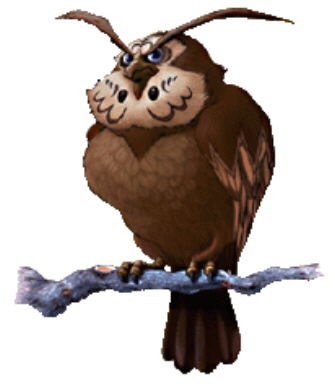
I also have to mention the wise-owl, whom Link encounters as a child. The owl’s true name is Kaepora Gaebora (now see if you can discover where the game tells you that! 😉 ) and he serves to enlighten Link on the ways of Hyrule in much the way that Sheik does when Link is an adult. The owl is a very cool character in my opinion, as he adds both a whimsical (think: Alice in Wonderland) but at the same time a mythical and mysterious, feel to the young Link’s world. The music that plays while you are talking to the owl is equally fitting. And there is one point in the game where the owl’s appearance will make you shed a tear.
But the greatest aspect of Ocarina of Time is, without a doubt, the dungeons. “Dungeons” are infamous in Zelda ever since the original Legend of Zelda 1, and they are well known for their head-scratching puzzles and very clever designs that force players to make use of all their weapons, including new ones which you almost always obtain from a dungeon treasure chest, a hallmark of the Zelda titles and one that is reinforced in full form with Ocarina of Time.
I must admit that going into this game I was not sure if the game and it’s dungeons would hold up to the very high marks that the game received upon it’s release, way back on the N64 in 1998. I also was not sure if the game would hold up to my nostalgic view of it’s greatness when I truly put it to the test by replaying the entire game once again.
But make no mistake! The Legend of Zelda: Ocarina of Time not only lived up to my expectations AND my nostalgia, but it EXCEEDED them! Not an easy feat when the game is long-remembered and highly regarded as one of, if not THE, greatest games of all time. But let me tell you, there is one reason why the game holds up so well. And naturally, why it is deserving of the high praise it gets.
Awesome Zelda fanvid (warning MAJOR spoilers in all aspects)
Put simply, the dungeon designs in Ocarina of Time are easily some of the best designs in the entire series! A bold statement for sure. The dungeons are a joy and a challenge from beginning to end. And if you have never played the game, then you will be in for quite the brain-stumper as you make your way through Link’s epic quest.
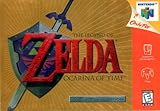 The reason I can say this matter-of-factly is due to my extensive experience with Ocarina of Time in the past. I have played through and beaten the game many times (including on the N64 when it first came out on that system, and when it was re-released on GameCube as part of the “Ocarina of Time/ Master Quest” collection) and so there were many puzzles that I distinctly remembered, making the game much easier to go through again than it would be for someone who has never touched it. And yet, even still, the game managed to stump me on more than a few occasions!
The reason I can say this matter-of-factly is due to my extensive experience with Ocarina of Time in the past. I have played through and beaten the game many times (including on the N64 when it first came out on that system, and when it was re-released on GameCube as part of the “Ocarina of Time/ Master Quest” collection) and so there were many puzzles that I distinctly remembered, making the game much easier to go through again than it would be for someone who has never touched it. And yet, even still, the game managed to stump me on more than a few occasions!
In particular, the Water Temple was just as tough as I remember it. I even managed to actually get so stumped in the Water Temple when I was a key short, that I had to basically go through the entire dungeon room by room looking for that one key that I did not get!
So don’t be fooled, even if you remember the game pretty well, you probably will not be able to recall how exactly to solve every puzzle in the game. So it’s enjoyable to play through again just on that basis alone.
As mentioned above, the dungeon designs in Ocarina of Time are fantastic. Generally you will be hitting switches to unlock doors, destroying all the enemies in a room to activate a hidden chest, solving puzzles and picking up Door Keys to unlock locked doors. You’ll also find a hidden Dungeon Map (which will give you a full map of the entire dungeon that you can check on the Map Subscreen, and a mini-map in the lower right corner), Dungeon Compass (which will show you the location of hidden treasure chests and what room the boss resides in on said maps), and, in some dungeons, the Boss Key, which naturally allows you to unlock the door to the room where the boss resides, in almost every dungeon. In addition to this, you will always get one new item or weapon and will be required to use it extensively to complete the dungeon and solve it’s puzzles. At the end of every dungeon you will fight a massive boss and several dungeons also have you fighting mini-bosses half-way through.
Puzzles come in a wide form and variety and are a joy to figure out. They range from simple hit-the-switch puzzles to block pushing to more complex floor navigation and everything in between. A quick example of one dungeon puzzle involves three spinning platforms with lava below, a lit torch in the middle that the platforms revolve around, and a switch on the wall that is frozen. The solution? Stand on one of the platforms until it’s lined up with the torch and shoot an arrow through the fire and into the switch. This will thaw the ice and activate it.
Water Temple Wallkthrough – Part 1 (SPOILER ALERT)
And all the dungeons are themed in some general way which helps make each dungeon feel very distinct. You will find dungeons that have objects that are not real but illusions, the aforementioned Water Temple which as you lowering and raising the water level as well as being required to constantly equip and unequip various equipment, a Fire Temple with multiple floors that involves saving some captives, a dungeon whose enemies are mostly electric and will shock you if you touch them, that’s set inside of a creature (with fleshy walls that bleed when hit) to a dungeon that mostly involves the manipulation of light.
And as stated above, you will not only get various items and weapons in these dungeons but you will also get new equipment, in addition to Magic Spells (that will drain your Magic Meter), as you explore the game world. Some of them are required while others (like the spells) are not, and some are easier to find than others. The footware in particular is very impressive, and for the first time Link will find different Tunics (i.e., various colors of clothing) that give him additional abilities instead of simply increasing how much damage he can take (which was the case in The Legend of Zelda: A Link to the Past).
You may even find an additional sword which requires two hands to wield, and consequently, does not allow you to use your shield at the same time (since you can’t hold both as it requires two hands to wield). And just like items and weapons, you can switch between your new equipment pretty quickly and easily by simply going into your subscreens and selecting them on the Equipment Subscreen.
All changes from the Equipment Subscreen are reflected on Link’s character model, including some of the “aside” equipment which is shown on the sidebar to the left of your standard equipment on the Equipment Subscreen. These items are equipped automatically and include larger bags for Bombs, Arrows and your Slingshot (which are not shown on Link’s character model), in addition to other Items that you will acquire, and be able to upgrade, throughout the game (such as a bracelet, which is shown on Link’s character model). Most of these upgrades are entirely optional, which means that you may go through the entire game without ever finding out how to increase the number of Bombs, Deku Nuts, Deku Sticks or Arrows that you are able to carry.
And that is part of the beauty of Ocarina of Time. The game, as stated above, is jam-packed with side-quests and mini-games, most of which will reward you with one of the items mentioned above. But that’s only the tip of the iceburg.
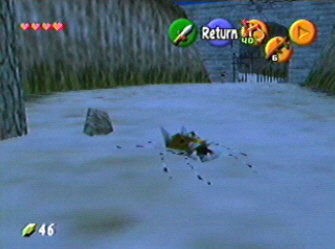
Much of your exploring in Ocarina of Time will be doing side-quests. There are a few major ones in the game and they include a search for “soft soil”, which you will encounter as small holes in the ground. These holes can be planted with a special seed (err, bean) that you can buy at Zora’s River. Planting them in the soft soil will allow you to access some previously unaccessible areas as an Adult, after the plant’s have grown. In addition, these holes will yield a Gold Skultulla if you drop a caught bug onto the soil.
Another major side-quest involves the search for Great Fairy Fountains. Some of these fountains you will inevitably find during the course of your adventure, while others are more hidden and optional, and thus can be missed. The Great Fairy’s will power Link up with Magic Spells and other abilities that will be very useful in your quest.
But in addition to searching for Pieces of Heart (as explained below), you will probably spend the majority of your side-quest time hunting for hidden spiders known as “Golden Skultullas”. These gold-colored arachnids only come out during night (except in dungeons, where they always reside) and can be discovered thanks to the unique noise that they make as they spin on their spot. Killing one of them will give you a token, and there are a total of 100 Gold Skultulla Tokens to find and collect hidden throughout the entire game! Collecting all of them is a humongous task, and although I have done it before in previous files while playing through Ocarina of Time, I did not collect all of them in my play through the game for this review. In fact I only collected around 60 of them!
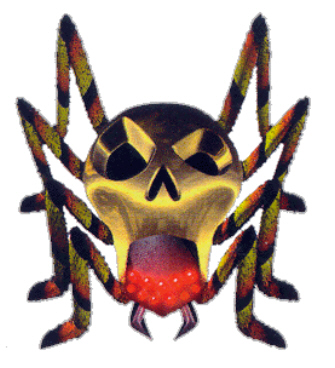
So if you do find them all, then give yourself a big pat on the back. Naturally, you will be rewarded for finding them all, although you really only need to collect 50 of them to get the best rewards. The end-game reward for finding all 100 Gold Skultullas is simply an infinite amount of money (which you should be able to decipher from the character who rewards you who says, bold in red, “I will make you very rich”) which is incredibly pointless at such a late stage in the game, as there is nothing for you to buy with the money (outside of potions). And like in all Zelda games money (in the form of rupees) is pretty readily available, and you will constantly earn it by opening treasure chests, finding holes in the ground (that typically lead to a treasure chest with money or a Gold Skulltula and/or sometimes a Heart Piece) and simply destroying shrubbery. The result is that you will typically have a lot or the max amount of money throughout the game.
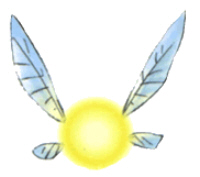 Also putting a damper on things as far as rupees are concerned is the fact that most of what you can buy in stores is stuff you can find or earn by killing enemies or sword-swiping shrubs or pots. So there isn’t much incentive outside of healing potions, and a fairy caught in the bottle is just as good, if not better, as the Red, Green and (the hidden) Blue Potions are, as a fairy will revive you if you keep it in the bottle and die with it in your inventory. Which essentially gives you double the amount of hearts you already own. Get three bottles and three caught fairys and you are pretty much good to go no matter what dungeon or boss you are facing.
Also putting a damper on things as far as rupees are concerned is the fact that most of what you can buy in stores is stuff you can find or earn by killing enemies or sword-swiping shrubs or pots. So there isn’t much incentive outside of healing potions, and a fairy caught in the bottle is just as good, if not better, as the Red, Green and (the hidden) Blue Potions are, as a fairy will revive you if you keep it in the bottle and die with it in your inventory. Which essentially gives you double the amount of hearts you already own. Get three bottles and three caught fairys and you are pretty much good to go no matter what dungeon or boss you are facing.
And that leads to another slight sticking point, Ocarina of Time is a pretty easy game. While I did die once or twice during the course of my adventure, I always had a fairy ready to revive me and thus I never truly died. I can say this becuase the number on my file select screen is zero. You see, the amount of times you die is reflected on the File Select Screen by a number. That number represents you how many times you have died, and has been a staple of the Zelda series since Zelda 1, even though they never actually tell you what that number means. (Lucky for you, I just did!).
Thankfully though, even though the bosses are not very tough (Volvagia above is way more threatening in this artwork than he is in the game), the game IS challenging thanks to the excellent dungeon designs and puzzles therein. The bosses are also all phenomenal design-wise (and look pretty cool) and are a real treat to fight and conquer. One of them in particular is a battle that takes place on a giant drum! Others will have you fighting a giant bomb eating dinosaur, a flaming, flying dragon and a electrified jelly-fish-like creature whose surface is covered by smaller electrified jellyfish.
Some of bosses are easily in my “top bosses of all time list”, ESPECIALLY the end game fights, which have to be seen to be believed. My brother commented that the first stage end boss was “More badass than Sephiroth from Final Fantasy VII“; praise doesn’t come any higher than that!
Back to the mini-games and side-quests, in addition to your search for Gold Skulltulas (which is entirely optional, but you will want to do so simply to increase how many rupees you can carry) you will also be searching for Pieces of Heart, another classic Zelda staple of the series. You will need to collect four Pieces of Heart in order to create a new Heart Container, thus giving you more health.
In addition to those side-quests, you also may discover, with some searching, an elaborate “trading sequence” which has you taking items you receive from NPCs (non-playable characters) to other NPC’s for another item. You mix and repeat until you end up with an optional, but extremely powerful, weapon known as the Biggoran’s Sword. These trading sequences originally started on the Game Boy Zelda game, The Legend of Zelda: Link’s Awakening, and have become a staple of the Zelda series.
In addition to these three huge side-quests, that can keep you quiet busy throughout your adventure, there are tons of additional mini-games that you can play.
Some of these mini-games include: (names may not be official)
Shooting Gallery: Use either your bow and arrow or Slingshot to shoot at moving or stationary gems that will pop-up.
Bombchu Bowling: Use the Bomchu item, a mouse-like bomb that will move on it’s own in a straight line where you set it, to target specific holes while obstructions try to block your Bombchu.
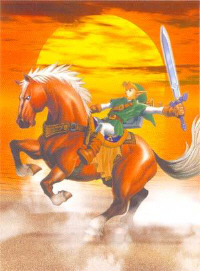 Treasure Guessing: You must choose which chest holds the key to the next room. A complete game of chance as there are only two chests to choose from. Although you can cheat in this game with an item that lets you see the truth.
Treasure Guessing: You must choose which chest holds the key to the next room. A complete game of chance as there are only two chests to choose from. Although you can cheat in this game with an item that lets you see the truth.
Zora Diving: Dive from the top of the Zora’s Domain waterfall and into the body of water below with the goal of collecting all the rupees in the water.
Horse Racing: Race your horse against an opponent. While racing you will also have to jump over fences. While it’s not too hard to beat your opponent, once you do that you will be tasked with an obstacle horse, which is just as hard if not harder. And much harder to complete it AND beat the record.
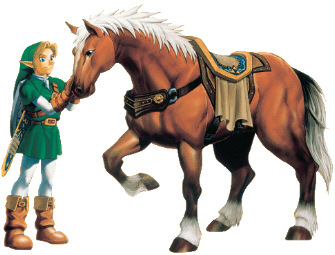 Horseback Shooting Range: While on horseback you need to use your bow and arrow to shoot at stationary targets as your horse moves. A bullseye on the target will net you more points.
Horseback Shooting Range: While on horseback you need to use your bow and arrow to shoot at stationary targets as your horse moves. A bullseye on the target will net you more points.
Cucco Rounding: The chickens from previous Zelda’s get the name “Cucco” in this game (which I took as Nintendo competing against Squaresoft’s “Chocobo” character) for the first time, and in Kakariko Village you will find a lady who tasks you with finding all of her Cucco’s and bringing them back to their pen.
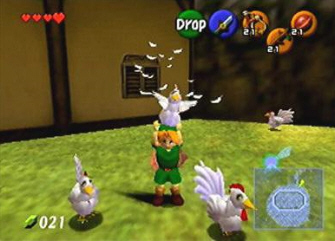
Lon Lon Ranch Cucco Hunt: The owner of Lon Lon Ranch, Talon (who, along with his brother Ingo, look suspiciously like Mario & Luigi), will task you with finding three special Cuccos amongst a gaggle of normal ones. The catch? The special ones look exactly the same, so in actuality you are simply racing to pick up as much as you can without picking up one you already lifted.
Frog Singing: Play one of the songs you have learned to this group of frogs to make one of them grow. Make them all grow to earn a special prize.
Lost Woods Ocarina Song Memorization: This game tasks you with memorizing an Ocarina tune that’s played by some skull kids in the Lost Woods. You have to repeat the notes they play. Each time you do so successfully, they add a note, until you’re required to play the entire group of notes in one go.
Lost Woods Stage Area: This place is hidden within some bushes in one of the Lost Woods rooms. Simply wonder through the grass near the butterflies until you fall into a hole. When you are here, you will get a different response depending on what face you show them.
Fishing: The Legend of Zelda: Ocarina of Time contains a deep fishing mini-game that you can find at Lake Hylia. The fishing mini-game was popularized in Ocarina of Time after it made it’s debut in The Legend of Zelda: Link’s Awakening for the Game Boy. To fish in Ocarina of Time, you must pay a small rupee fee and then you are given a fishing rod. The rod can be used on a lack full of fish. You press the B Button to cast your line, and down+A to set it when a fish grabs. To help lure fish you can move the lure with the A Button, control stick or R Button. To reel a fish in after you grabs and you’ve set it with down+A, you keep pressing B while holding the R Button and directions on the control stick.
There are lots of different fish of various sizes, and you are rewarded with a Piece of Heart when you are a kid, and a special item when you are an adult, for catching a huge lunker of a fish. There are even a few secret/fun things you can do while fishing, including stealing the employees hat and finding a special “Sinking Lure”. Although there are only two real rewards for playing the fishing mini-game, the game was haraulded at the time of Ocarina’s release for good reason, it’s fun to play!
Happy Mask Shop: Last but not least, is the Happy Mask Shop, which deserves special mention and is more of a side-quest than a mini-game. This shop opens up once you have gained access to Death Mountain from Kakariko Village. The shop is found in the Hyrule Market and from the shop you borrow a mask “for free”. Once you have borrowed a mask, you can show it off to people to get different reactions. This is fun at first cause you’ll want to talk to everyone and see how they react, but once you hit the third mask or so you’ll notice that they will start to repeat their lines.
The goal is to find a certain person in Hyrule who wants the mask and will be willing to buy it from you. Once they do you pay back a fee for borrowing the mask and you’ll get a new model. There are four major masks that you can borrow and once you have found the person you sell each one too you will unlock a special “Mask of Truth” that you can use to talk to the random gray stones called “Gossip Stones” that you find throughout the game. This serves no true purpose but is fun to do and they will give some interesting tidbits of expositionary info that helps in fleshing out Link’s world. After unlocking the Mask of Truth you will also be given three “Race Masks” to play around with. Oh and by the way, try using all your money after you’ve given a mask away so that you can’t pay the “Happy Mask Salesman” back, YOU WILL NOT REGRET IT!
And this is not even the full list of mini-games, although I think I covered the majority of them. Although there are a lot of them to play and they will keep you occupied throughout your adventure, the mini-games are not something you will play for fun (with the possible exception of the fishing and Happy Mask Shop side-quests). Rather you will simply play them until you’ve earned whatever it is you seek, and then move on. The games are not fun in the sense that you will really want to play them over and over. And that’s a bit disheartening, especially since all you get after the main reward is typically 50 rupees, something you will rarely need much less want.
The world of Zelda: Ocarina of Time is very fleshed out though, and it will take you through all manner of environments and places, from forests to volcanos to streams and rivers to frozen ice and dark palaces. In addition, you will grow to like the random characters that inhabit Link’s world. Even if it may not seem like it at first. By the end of the game you will recognize all of them. Which is especially neat if you are planning on playing the follow up, The Legend of Zelda: Majora’s Mask, which re-uses all of the same character models, and sometimes retains their personalities.
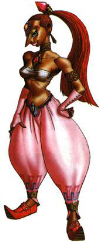 As mentioned above, Ocarina of Time also dives into the Zelda lore unlike any previous Zelda game, and set the benchmark for all games to come. The way the game ties together the Royal Family of Hyrule and the Sheikah with the Kokori, Goron, Zora and Gerudo tribes is very interesting and the new character types, the green-clad forever-children people of the forest known as the Kokori, the water fish-like people known as the Zora, the mountainous rock-eating people known as the Goron, and the all female desert thieves known as the Gerudo, are all really cool and interesting people’s. They really help to give Ocarina of Time a very unique feel and a world that feels realistic and natural, especially given that it is all linked.
As mentioned above, Ocarina of Time also dives into the Zelda lore unlike any previous Zelda game, and set the benchmark for all games to come. The way the game ties together the Royal Family of Hyrule and the Sheikah with the Kokori, Goron, Zora and Gerudo tribes is very interesting and the new character types, the green-clad forever-children people of the forest known as the Kokori, the water fish-like people known as the Zora, the mountainous rock-eating people known as the Goron, and the all female desert thieves known as the Gerudo, are all really cool and interesting people’s. They really help to give Ocarina of Time a very unique feel and a world that feels realistic and natural, especially given that it is all linked.
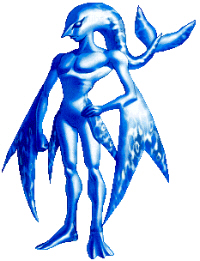 Even before you gain easier ways to travel as an adult, you will find locations within the world that will instantly take you from one part to another. Which means that if you pay attention to your surroundings, you’ll find easier ways to get from point A to point B. Which is just another testament to Nintendo’s brilliant design of the entire Hyrule game world in The Legend of Zelda: Ocarina of Time.
Even before you gain easier ways to travel as an adult, you will find locations within the world that will instantly take you from one part to another. Which means that if you pay attention to your surroundings, you’ll find easier ways to get from point A to point B. Which is just another testament to Nintendo’s brilliant design of the entire Hyrule game world in The Legend of Zelda: Ocarina of Time.
Graphically, Ocarina of Time is very rough around the edges, as you’d expect from a Nintendo 64 title of this age. The worst offender is probably the character designs and geography, which all feature very sharp edges, lots of points. While it’s not of Final Fantasy VII quality, it does make all the characters look a bit blocky.
The textures of course are also blurry, especially if you are playing the original Nintendo 64 version as opposed to one of the GameCube re-releases. However, once you get into the game, you will still be awed by some of the graphics and effects. While the game won’t necessarily blow you away, the first time you turn into Adult Link you’re jaw will definitley hit the floor if you’ve never seen the sequence, and Death Mountain 7 years later still impressed the first time you see it, especially in from close-up! However still one of the most impressive aspects of the game is the entire ending sequence . . . Those who’ve played the game will know what I’m talking about. And if you haven’t, then it’s yet another reason why you MUST experience this game.
Musically, Zelda: Ocarina of Time has an absolutely fantastic soundtrack. In fact I’d urge you to pick up one of the myriad of Zelda: Ocarina of Time soundtracks that you can get online (note that the Japanese original soundtrack album has twice as many tracks as the U.S. release) as well as check out some awesome Zelda: Ocarina of Time remixes (click on “Songs” to see each one) from the great video game remix site www.ocremix.org.
Back in the day though, when Ocarina of Time was first released, some people complained that it didn’t sound like Zelda music, and to a degree this still remains true. If you are expecting a fun, upbeat diddy like that of The Wind Waker, then you will be sorely disappointed with the music in The Legend of Zelda: Ocarina of Time (with the possible exception of the mini-game [Bombchu Bowling] and Happy Mask Shop music), however the music seems to just get better and better the more you play.
What really puts the music over the top though is the great dungeon themes that you will hear when you are Adult Link. In fact, the tune that plays for the last Temple in the game is one of my personal favorites.
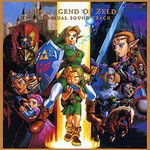 Other individual stand-out tracks and personal favorites include *possible spoilers*: The Water Temple, Gerudo Valley, the Temple of Time, Goron City, The Forest Temple, Zora’s Domain, Hyrule Field, the Windmill and Inside Jabu Jabu’s Belly *end spoiler*.
Other individual stand-out tracks and personal favorites include *possible spoilers*: The Water Temple, Gerudo Valley, the Temple of Time, Goron City, The Forest Temple, Zora’s Domain, Hyrule Field, the Windmill and Inside Jabu Jabu’s Belly *end spoiler*.
I was never too big of a fan of the opening theme . . . It’s also impossible to talk about Ocarina of Time music without mentioning the teleport songs you learn in the game. Which are great, orchestral-like ditties that have become beloved classic video game tunes in their own right.
Finally, it must be noted that The Legend of Zelda: Ocarina of Time contains no readily apparent remixes of previous Zelda tunes, which came as a real shocker to a legion of Zelda fans when the game was originally released way back in 1998. The only tune that readily sticks out in my mind that resembles classic Zelda music is the Hyrule Field Theme, which resembles the main Zelda theme that gamers the world over know and love.
And yes, what you may have heard is true, Ocarina of Time lacks a remix of the classic Zelda Overworld theme, the one everyone knows and loves. However, the music in Ocarina of Time is it’s own beast. It’s so good, that it doesn’t need classic Zelda remixes to carry it. The music in the game was also composed by the same guy who has done every other Zelda theme you know and love, Koji Kondo.
As far as the sound effects go, they are classic Zelda and have pretty much remained the templete for all other 3D Zelda games onward. They work fine, although I must say that Link’s grunts and screams can get quite annoying, although mostly when you have to do lots of rolling.
But best of all, Ocarina of Time is quite simply FUN. Add this sense of fun to the myriad of secrets hidden all over Hyrule (try bombing a lone tree to the side of Hyrule Castle) to the outstanding gameplay design to the tons of side-quests and the interesting storyline (which really picks up once you reach adult form) to the phenomenal bosses and incredible end boss sequence and you have, quite simply, one of Nintendo’s greatest modern masterpieces.
The Legend of Zelda: Ocarina of Time has received high marks for a reason. It is one damn good game. If you have yet to experience Ocarina of Time, then you owe it to yourself to try it out. And since the game was added to the Wii Virtual Console, it is more easier (and cheaper) than ever before to do so.
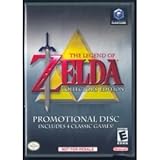 But if you are looking for the perfect version, then you may want to track down the Ocarina of Time/Master Quest or the Zelda Collection promotional discs, as both discs feature what is arguably the best version of the game, as the graphics were improved and the rumble feature is intact (missing from the Wii Virtual Console version, and only available in the N64 version with a corresponding Rumble Pak accessory plugged into your controller) and thanks to the Wii’s backwards compatibility with GameCube discs, these versions of the game will play just fine on your Wii. But if you can’t get a hold of the aforementioned versions, then definitely download it on the Wii Virtual Console. You will NOT be disappointed.
But if you are looking for the perfect version, then you may want to track down the Ocarina of Time/Master Quest or the Zelda Collection promotional discs, as both discs feature what is arguably the best version of the game, as the graphics were improved and the rumble feature is intact (missing from the Wii Virtual Console version, and only available in the N64 version with a corresponding Rumble Pak accessory plugged into your controller) and thanks to the Wii’s backwards compatibility with GameCube discs, these versions of the game will play just fine on your Wii. But if you can’t get a hold of the aforementioned versions, then definitely download it on the Wii Virtual Console. You will NOT be disappointed.
I would only suggest playing the N64 version if you still have an N64 around with controller/rumble pak, and you want to experience the game as it was originally intended. The N64 controller also works best with the game, due to the four C Buttons, and the Z Trigger Button, although the GameCube controller definitely does an admirable job.
You may also want to note that the GameCube versions do contain a few SLIGHT changes, including a particular bloody scene whose blood color was changed from red to green, the removal of the chant from the Fire Temple as well as the removal of a few symbols from the game (so as not to offend Muslims) and a few other possible slight differences.
Either way, do not let the opportunity to play one of the highest rated Nintendo games of all time pass you by. It should be required playing for all modern video game fans, and stands as a true testament not only to the genius of Nintendo and director Shigeru Miyamoto (who passed the series along to Eiji Aonuma with The Legend of Zelda: The Wind Waker and all subsequent Zeldas outside Zelda: The Minish Cap) but also to the power of design even on a lower-end system such as the Nintendo 64, which allowed those who put the effort to create some of the greatest games of the 32/64-bit era.
FUN FACTOR: 10
The Legend of Zelda: Ocarina of Time is an enjoyable game from start to finish. There’s no arguing that. And unlike a lot of games, the dungeons seem to just keep getting better and better, even the last dungeon is a blast and the boss fight and ending NEED to be experienced by every gamer on the face of this planet. On top of that, the game is absolutely packed with content it and it’s virtually guaranteed that you will not get everything on your first play through the game without using a strategy guide. Ocarina of Time is a fun game, whether you are just doing side-quests and mini-games or completing the main quest. It’s definitely worthy of the highest mark.
Graphics: 8.0
Zelda isn’t quite the looker it once was. All the characters are blocky with pointed edges, and the textures are all quite blurry. But regardless the game will still surprise you graphically, just wait until you see Death Mountain when you are an adult for the first time.
Music & Sound: 10
The music in Zelda: Ocarina of Time is fantastic, and it only gets better the further you get into the game. In fact the tune of the last dungeon is one of my favorites. The sound effects can be grating and get repetitive, especially when you have to roll a lot . . . which you will. But regardless, Ocarina of Time set the standard for Link’s yells and screams that have been carried over into other games. Either way, you can’t go wrong with the sound in the game.
Ingenuity: 9.0
Zelda: Ocarina of Time set a ton of standards that now have become formulic and common place. But for it’s time it was groundbreaking. This includes the ability to lock on to targets, the context sensitive Action Button and the auto-jumping and climbing to streamline the controls. This was also the first Zelda to let you map more than two items at once.
Replay Value: 9.5
There is SOO much content packed into Ocarina of Time that it’s almost mind-blowing. 100 Gold Skulltalus to find, numerous mini-games to compete in, side-quests like the Biggoran Sword trading sequence, a ton of Heart Pieces and bundles of secrets hidden all over the place and quite a few optional items and upgrades. Ocarina of Time, like Super Metroid, is a game that is an absolute challenge to complete 100% and therefore, offers lots of replay value. Although once you beat it, there isn’t any incentive to play it again, and there are no unlockables.

